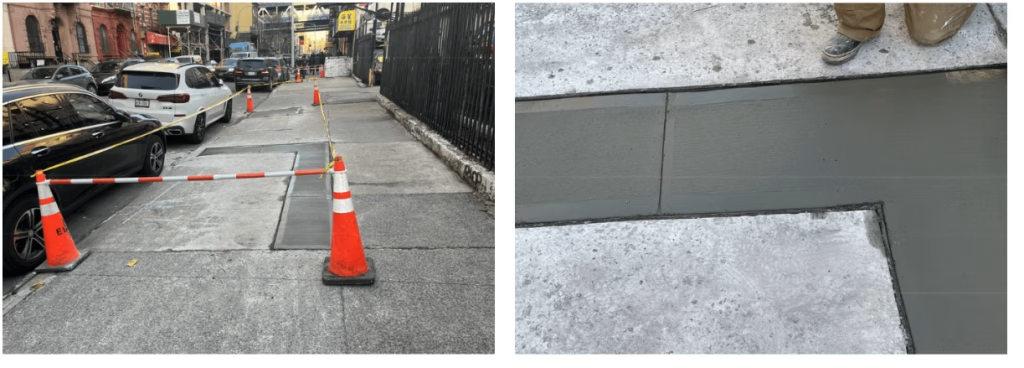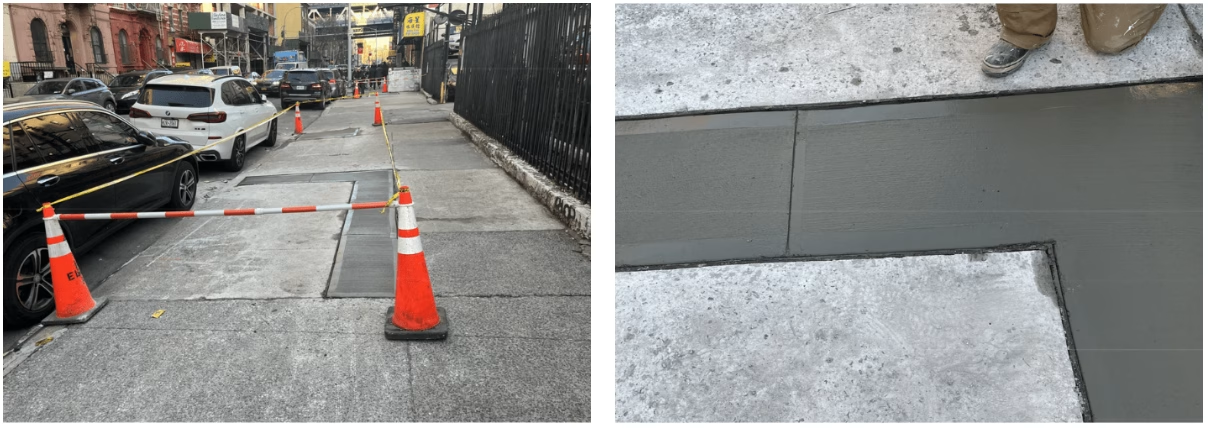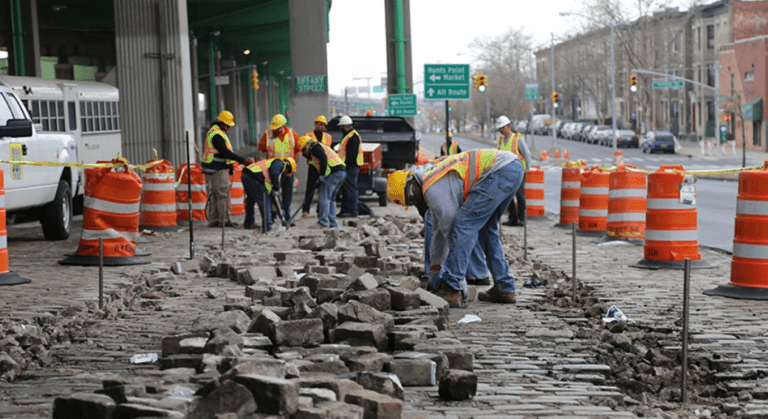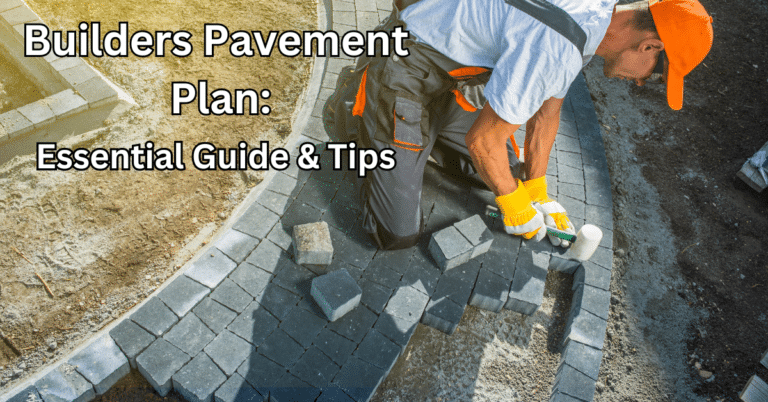Last Updated on August 18, 2025 by Jeffrey Calderon
Navigating NYC Sidewalk Permit Requirements: A Guide

Living or working in New York City means dealing with sidewalks daily. They’re essential pathways, but they also come with rules, especially when you need to repair or change them. Understanding the NYC sidewalk permit requirements is crucial before you start any repair work, big or small.
Ignoring these rules can lead to headaches like fines and delays. This guide will walk you through the essential NYC sidewalk permit requirements. You’ll learn what needs a permit required, how to apply, and why following the process matters for every private homeowner and property owner.
Table Of Contents:
- Why Bother with Sidewalk Permits in NYC?
- When Do You Absolutely Need a Permit?
- Types of Sidewalk-Related Permits
- Understanding NYC Sidewalk Permit Requirements
- Working with the Right Contractor
- Common Mistakes That Cause Problems
- What If You Skip the Permit?
- Helpful Resources
- What About Emergencies?
- Conclusion
Why Bother with Sidewalk Permits in NYC?
Getting a permit might seem like just another bureaucratic step in York City. But these regulations are in place for good reasons. They help keep sidewalks safe for everyone walking on them.
Properly maintained sidewalks prevent trip hazards and accidents. The permit process helps the city make sure any work done meets safety standards. It’s about public safety first and foremost.
Following the permit process also protects your property value. Unpermitted work can cause problems down the road, especially if you decide to sell. Plus, it keeps you on the right side of the law, avoiding violations and penalties from the NYC DOT (New York City Department of Transportation).
When Do You Absolutely Need a Permit?
So, when does sidewalk work trigger the need for official permission? Generally, any significant sidewalk construction, replacement, or repair sidewalk job requires a construction permit. Think beyond just patching a tiny crack; major sidewalk repairs almost always need approval.
You definitely need a permit for installing a completely new sidewalk (sidewalk installation). Replacing large sections of existing sidewalk also falls under this rule, often measured in square footage or linear feet. Major repairs involving multiple concrete flags (squares) will likely need DOT approval too.
Other activities needing permits include creating new curb cuts for driveways or loading docks. Installing permanent structures like large planters, newsstands, or café barriers on the sidewalk requires permission. Even putting up scaffolding or a sidewalk shed that obstructs pedestrian traffic needs a specific permit, often involving projects requiring sidewalk closure.
Minor Repairs vs. Major Work

Not every little fix needs a full permit. Very minor repairs, like filling a small crack less than half an inch wide or resetting a single loose paving block, might not require a formal sidewalk construction permit. However, the definition of minor can be subjective and strictly defined by the DOT.
It’s always best to check with the NYC DOT if you’re unsure, especially for private homeowners doing the work themselves. Performing work you thought was minor, only to find out it needed a permit required, can lead to violations. A quick call or review of the guidelines on the official website can save you trouble later.
Remember, the responsibility for maintaining the sidewalk generally falls on the adjacent property owner. This includes making necessary repairs promptly. Ignoring needed sidewalk repairs can lead to DOT violations, even if you haven’t done any work yet.
Types of Sidewalk-Related Permits
The DOT issues different construction permits depending on the work you’re doing. A standard Sidewalk Construction Permit is the most common one for sidewalk repairs and replacements. This covers the actual work on the concrete or other pathway material.
If you need to dig into the sidewalk, perhaps to access utilities like a damaged water line or heating pipe, you’ll need a Sidewalk Opening Permit or simply an opening permit. This is separate from the permit for the sidewalk restoration itself. Utility work often has specific backfill and restoration requirements.
Work that obstructs pedestrians requires careful planning. If you need to block pedestrian flow temporarily, like with construction barriers or equipment, you’ll likely need a separate permit for temporary street or sidewalk closure. Scaffolding that overhangs or rests on the sidewalk requires its own specific permits too, and these permits apply strict safety rules.
For very large projects, a Construction Control Permit (CCP) might be necessary. This usually applies to major building construction adjacent to the sidewalk, ensuring overall site safety and coordination. Different sidewalk construction permits apply depending on the complexity and impact of the job.
Installing things like benches, bike racks, or large planters might fall under Street Furniture permits. Each permit type has its own application details and potential permit fee. Researching the specific dot permit needed for your job on the york city department website is step one.
Understanding NYC Sidewalk Permit Requirements
Okay, let’s get into the details of the permit application process. The NYC DOT oversees these permits through its borough offices and online systems. They have specific steps and documentation you need to follow.
Being prepared will make the process smoother. It involves gathering information, submitting forms correctly, potentially including a mandatory affidavit, and paying fees. Knowing the basic procedures helps avoid delays.
Gathering Your Information
Before you even start the application, you need details ready. You’ll need the exact address of the property where the work will happen. You also need to know the property’s Block and Lot number, which you can find on city records or your property tax bill.
A clear description of the work scope is essential for the permit application form. This means detailing the dimensions (length, width, sometimes linear feet) of the sidewalk area being repaired or replaced, the materials being used (e.g., 4-inch concrete, specified type), and the reason for the work (e.g., correcting a DOT violation, general upkeep). The person applying needs to provide accurate contact information for the property owner and the contractor executing work.
Crucially, your contractor must be a licensed contractor registered with the NYC Department of Consumer and Worker Protection (DCWP) and carry appropriate insurance. You’ll need to provide proof of their license and insurance with your application. Make sure their insurance meets the city’s minimum requirements, often naming the City of New York City as additionally insured.
Submitting the Application
Most permit applications are now handled online through the NYC DOT’s permit management system, often called NYC STREETS. You or your contractor will need to create an account. The system guides you through filling out the necessary application form.
You’ll upload required documents directly to the portal. This usually includes detailed site plans or sketches showing the proposed work dimensions and location relative to property lines and curbs. Proof of contractor insurance is almost always required, and sometimes a form verifies that adjacent property owners have been notified if the work impacts them.
Depending on the project’s scale and location, other documents might be needed for the completed application. For instance, work near major transit hubs, in historic districts, or affecting city trees could require additional permits or reviews. Be prepared for potential requests for more information from the city department.
While most processes are online, for certain situations or specific forms found in appendix sections of DOT guidelines, you might need physical copies. In rare cases requiring mail, ensure you include a stamped self-addressed envelope if an original returned document is expected. However, relying on the official website and online portal is the standard basic procedures now.
Fees and Costs Involved
Getting a construction permit isn’t free. There are application fees associated with most sidewalk permits. The exact permit fee can vary depending on the type of permit (sidewalk construction permit, sidewalk opening permit, etc.) and the extent of the work (e.g., calculated per linear feet or square foot).
You can usually find a fee schedule on the NYC DOT website or within the permit portal. Expect fees for the initial application review. There might also be fees for inspections conducted by the DOT before, during, or after the work is completed to verify compliance.
Payment methods can vary, but often online payment is available. For larger fees or specific circumstances, payment by certified check might be required. Budgeting for these costs, including potential inspection fees, is an important part of planning your sidewalk construction project.
In some cases, especially for larger projects or those involving significant sidewalk closure or excavation, the city might require a bond. This acts as security to ensure the work is completed correctly and the area meets all restoration requirements. The bond amount varies based on project size and risk.
| Potential Cost Item | Typical Range (Estimate) | Notes |
|---|---|---|
| Permit Application Fee | $70 – $500+ | Varies by permit type (sidewalk construction permit, opening permit), scope, and linear feet. |
| Inspection Fees | $50 – $200+ per inspection | May require multiple inspections (initial, progress, final). |
| Plan Review Fees (if applicable) | Variable | For complex sidewalk installations or projects requiring sidewalk closure. |
| Bond Requirement | Variable ($1,000s – $10,000+) | Usually for larger projects, significant obstructions, or extensive excavation. Refundable upon satisfactory completion. |
| Expediter Fees (optional) | $1500 – $2500 | If hiring a professional to manage the permit application process. |
How Long Does It Take?
Permit approval times can vary quite a bit once the completed application is submitted. Simple, straightforward sidewalk repair permit requests might be processed relatively quickly, perhaps within a few business days to a couple of weeks. But don’t count on instant approval; always plan ahead.
More complex projects, like those needing detailed plan reviews, coordination with other agencies (e.g., Parks Dept. for trees, DEP for water/sewer), or involving multiple construction permits, can take significantly longer. Factors like the NYC DOT‘s current workload, the complexity of the review needed for sidewalk installations, and the completeness of your application heavily influence the timeline before a permit issued status is granted.
It’s smart to apply well in advance of when you want to start executing work. Don’t schedule your licensed contractor or order materials assuming the nyc dot permit will arrive by a specific date. Build buffer time into your project schedule for the permitting process, potentially several weeks or even months for complex jobs.
Working with the Right Contractor
Choosing the right contractor is incredibly important for sidewalk construction projects in NYC. You need someone who understands the city’s specific rules, material specifications, and restoration requirements. They also need the proper licenses and insurance acceptable to the york city department.
Always hire a licensed contractor registered by the NYC DCWP for home improvement or specifically as sidewalk builders or builders pavement experts if possible. Verify their license status online using the DCWP lookup tool. Ensure they carry general liability insurance and workers’ compensation insurance that meets the city’s requirements for construction permits, including naming the City of New York as an additional insured.
An experienced NYC contractor will be familiar with the NYC sidewalk permit requirements and the application process, possibly having contacts at the local borough office (e.g., near Water Street for Manhattan). They can often handle the permit application for you, navigating the online portal and requirements. Discuss permit responsibility clearly before signing any contract to avoid confusion about who the person applying is.
Common Mistakes That Cause Problems
Property owners and contractors often run into trouble by making avoidable mistakes. One of the biggest is starting work before the permit issued document is actually in hand and posted at the site as required. This can lead to immediate stop-work orders and significant fines, regardless of how small the initial repair work seemed.
Another common issue is submitting an incomplete or inaccurate permit application. Missing documents (like insurance certificates), incorrect property details (Block/Lot), or vague work descriptions will cause delays and rejection. Double-check everything before you submit the application form electronically.
Using an unlicensed or uninsured contractor is a major risk for private homeowners. It not only violates city rules but also leaves you financially unprotected if damage occurs or workers are injured. Always verify credentials before executing work begins.
Finally, make sure the actual work done matches the approved plans specified in the nyc dot permit. Deviating from the permit scope (e.g., extending the work area, changing materials) without obtaining an amendment or new permit can invalidate the original permit required approval. If plans change mid-project, contact the NYC DOT immediately.
What If You Skip the Permit?
Thinking about just doing the sidewalk repair or replacement without a construction permit? It might seem quicker or cheaper initially, but the potential consequences are serious. Getting caught performing unpermitted sidewalk construction can be costly and complicated.
The NYC DOT Highway Inspections unit regularly inspects sidewalks throughout the city. If they find unpermitted work, they will issue a Stop Work Order immediately. You’ll then face violation notices (Notice of Violation or NOV) and potentially significant fines.
You’ll likely be required to remove the unpermitted work entirely and restore the sidewalk pursuant to DOT standards, this time with a properly obtained permit. This means paying for the work twice (demolition and correct reconstruction), plus penalties and possibly re-application fees. Ignoring violations can lead to more legal trouble, judgments, and even liens against the property.
Unpermitted work can also create major issues if you ever try to sell or refinance your property. It can show up in property searches, title reports, and surveys, potentially jeopardizing deals or requiring costly remediation before closing. Following the NYC sidewalk permit requirements from the start is the safest and ultimately most cost-effective path for all private homeowners and property managers.
Helpful Resources
Navigating the permit process can feel complex, but help is available. The official website of the NYC Department of Transportation (nyc dot) is the primary source for information. Look for sections on Street Works Permits, Sidewalks, or Construction Permits.
Their website often has guides, FAQs, fee schedules, links to the online permit portal (NYC STREETS), and standard detail drawings. You can usually find contact information for specific NYC DOT borough offices (like the one at 55 Water Street for Manhattan) if you have questions. Don’t hesitate to reach out to the relevant city department directly for clarification on sidewalk construction permits.
Detailed specifications and rules might be formally documented in appendices to DOT regulations or guidelines. Check the website for links where this information might be obtained in appendix or found in appendix. Sometimes, specific forms or procedures can also be obtained in appendix sections of larger documents related to street work.
For complex projects, some property owners hire permit expediters. These are consultants who specialize in preparing and submitting permit applications in New York City. While they charge a fee, their expertise can sometimes streamline the process, especially for projects requiring multiple permits or approvals.
What About Emergencies?
Sometimes, immediate repair work is necessary due to safety hazards or utility issues. Situations like a sudden sidewalk collapse, a major water main break undermining the pavement, or critical heating pipe repairs might qualify. Even issues arising from an upstream connect error or connection termination might necessitate urgent sidewalk opening.
In genuine emergencies posing immediate danger, work may sometimes begin before a formal permit issued document is received, but notification to the DOT is still crucial. Typically, the contractor must contact the DOT immediately (often via a 24/7 emergency line) to report the situation and the intended work. A formal permit application must then follow as soon as possible, usually within 24-48 hours.
Abusing the emergency process for non-urgent work can lead to penalties. The NYC DOT will verify if the situation truly constituted an emergency requiring immediate action before permit issuance. Always document the emergency condition (photos, reports) thoroughly.
Conclusion
Dealing with sidewalks in New York City means understanding the rules set by the NYC DOT. Getting the right permissions, whether it’s a sidewalk repair permit or a full sidewalk construction permit, before you start any major repair or construction is vital. It’s about public safety, protecting your property investment, and avoiding costly penalties and delays.
While the process involves paperwork (permit application form), potential fees (permit fee), and coordination, knowing the NYC sidewalk permit requirements makes it much more manageable. Remember the key steps: identify the correct permit (opening permit, construction permit, etc.), gather necessary information, use a licensed contractor, submit a completed application, and wait for the permit issued notification before starting.
Plan ahead, work with qualified sidewalk builders, ensure compliance with restoration requirements, and always check with the NYC DOT or consult their official website if you’re unsure. Following the correct basic procedures for NYC sidewalk permit requirements ensures your project goes smoothly, avoids violations, and keeps city walkways safe for millions of New Yorkers.

About the Author
Jeffrey Calderon has worked with contractors for 21 years and has extensive experience with DOT.






